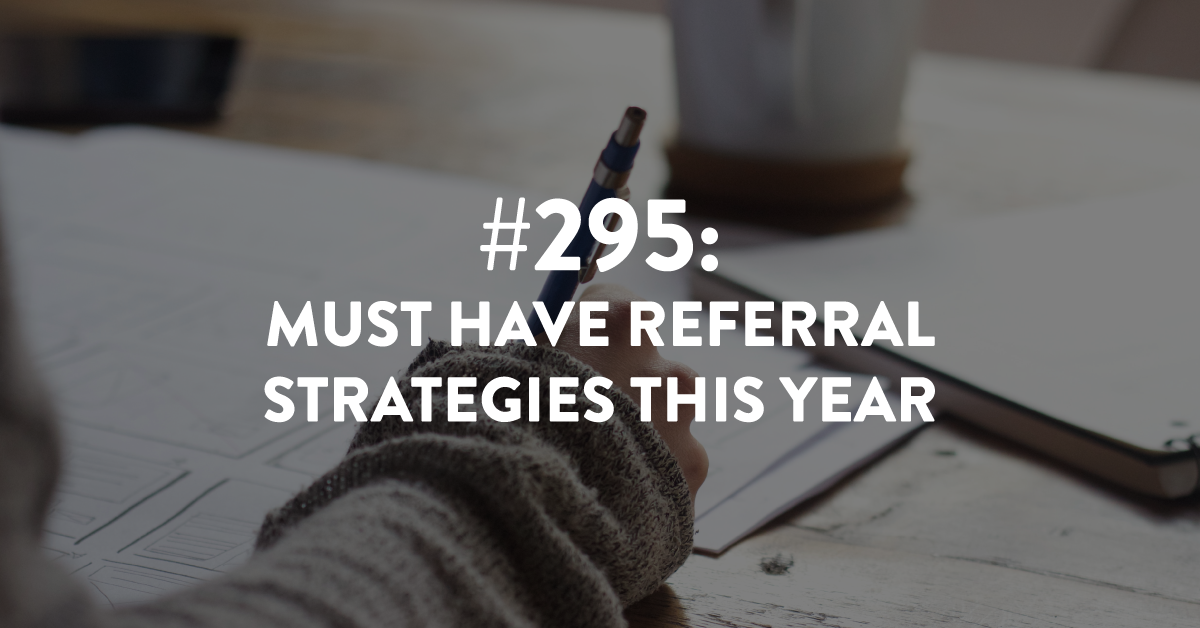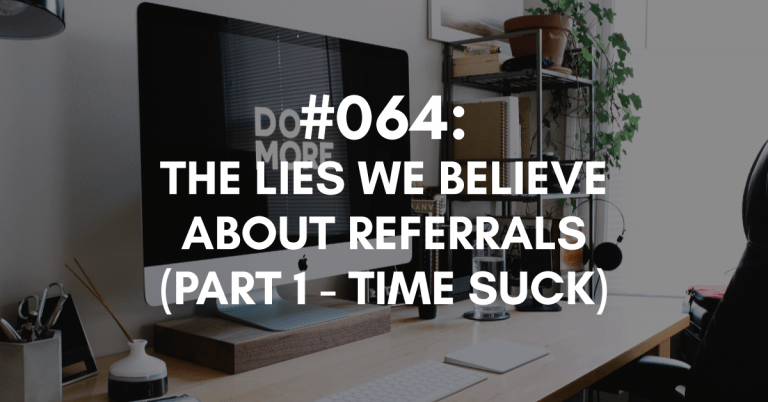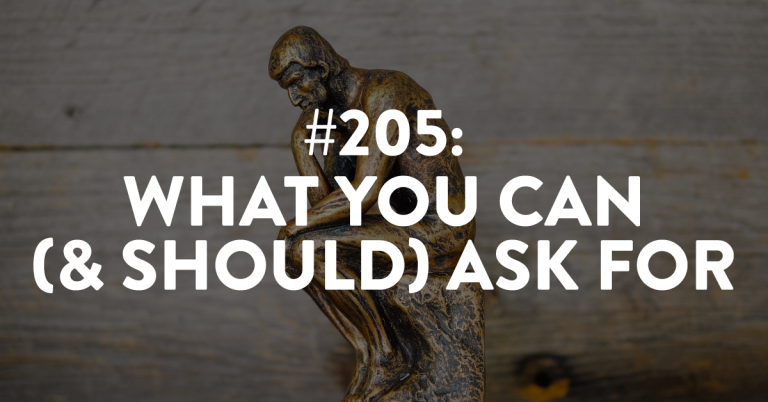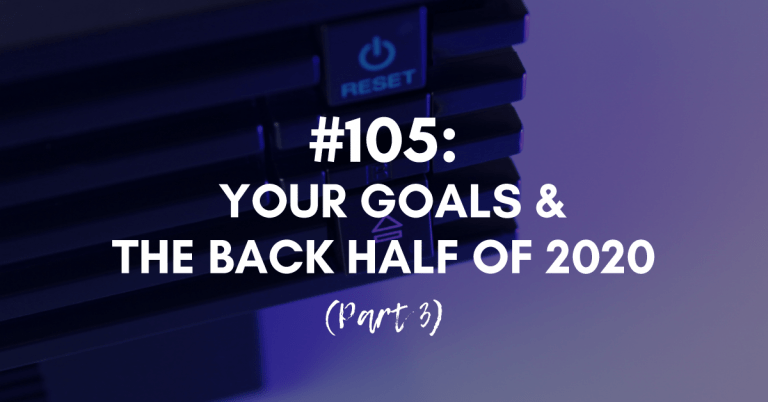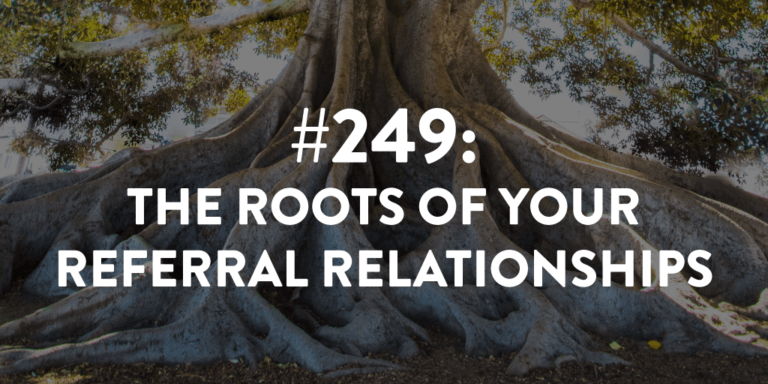Ep #295: Must Have Referral Strategies This Year
As we enter a new year, it’s crucial to adapt our referral strategies to the current business environment. In this episode, we explore ways businesses are shifting in 2024 and how to leverage your referral opportunities effectively. Here are three key referral strategies and a bonus tip to maximize your referral potential.
Strategy #1: Communicating Changes to Your Business Model
If you’re changing your business model, ideal client, or rates, inform your referral sources. Failure to communicate these changes can result in misaligned referrals.
Strategy #2: New People Referring You
It’s important to continuously cultivate new referral sources as existing ones may change or cease to refer. The process is simple but requires consistent execution and the right language. Cultivating new referral sources is essential for sustained business growth.
Strategy #3: Simple Thank You for Referrals Received
An often overlooked practice is sending handwritten thank-you notes for each referral received. This small gesture can have a significant impact on future referrals. For guidance on what to say and the type of card to use, refer to episode #052.
Bonus Strategy: Track Your Referrals
Tracking this data informs future strategies and helps identify who to focus on.
Stay tuned for more episodes this month, where we will expand on these strategies. Check out the links below for my free referral trackers, which can help you keep track of your referral sources.
Links Mentioned During the Episode:
Check out previous episode #238 for last year’s Must Have Referral Strategies and episode #052 for everything you need to know about writing a handwritten thank you note.
Download my free referral tracker so you capture and track the right info when you receive a referral
Download my free look back tracker to easily pull the right data so you can pinpoint with clarity exactly who has referred you in the past.
Learn how to work with me inside my Building a Referable Business™ coaching program. Check out the program and then apply to see if you’re a fit.
Next Episode:
Next episode is #296, which is another episode created with you and your needs in mind.
Download The Full Episode Transcript
Read the Transcript Below:
Stacey Brown Randall: Since each year can be a little bit different than the year prior, it means you need to focus on executing particular referral strategies over others as each new year begins. Let’s talk about the 2024 must-have referral strategies.
Hey there, and welcome to episode 295 of the Roadmap to Referrals podcast, a show about helping you build a referable business. I’m your host, Stacey Brown Randall. My journey from a business failure to a successful business now 10 years in, I know generating referrals naturally and consistently has made all the difference. Working with clients around the world, we leverage the science of referrals, protect relationships above all else, and help you build a referable business.
So last year on the podcast for episode 238, which I will link to on the show notes page for this episode, but last year in episode 238, I talked about a few of the must-have strategies, taking into account how most of the world was back to in-person events and then, of course, the impact that that can have on generating referrals.
The strategies focused on knowing things like what to say when you’re in a networking event and you get good old word of mouth buzz. We focus on the strategy of knowing how to flip that into a referral and knowing how to plant referral seeds while in conversation at networking events.
Some of the other must-have strategies for last year were focused around the fact that in-person and, of course, virtual events, well, in-person was back. Virtual events are here to stay. And we just needed to remind ourselves of what we needed to do to be able to really leverage referral opportunities with the changing times and with the changing of the year.
So there’s a shift I see now happening in many businesses for this year. So I want to address that in this year’s episode dedicated to our must-have referral strategies. And of course, I’m actually going to expand on this over the next couple of episodes as well through this month of February, but really focusing on a couple that you need to know.
I’ve got three and then a bonus. And then of course, we’re gonna kind of expand that over the next couple episodes as I talk about this and go a little bit deeper.
Okay, so here are some of the must-have referral strategies for this year. This doesn’t take away, of course, the strategies that I believe that you should have functioning and running and executing in your business every year.
Like, if you have referral sources, people have referred you in the past, every single year you should be taking care of those referral sources. You should have a plan in place, you should know what your touch points are gonna be, you should understand the language you’re going to use, and you should make sure that you execute on those touch points consistently.
That’s like never going away. But there are some things shifting and changing, and I’m seeing it with my clients that are in any of the programs that I have. I’m seeing it in conversations when I meet with clients or I’m at speaking engagements.
I started to see this shift a little bit some last year, and I think it’s only going to accelerate for some businesses this year. So maybe not all three of these must-have referral strategies are must-haves for your business, but I can almost guarantee at least one or two or maybe a third might just be.
So number one. If you’re one of the many, many businesses that are shifting your model in any way, or you’re adjusting your ideal client, like the who you wanna work with, or maybe you’re making just other big shift changes to your business, please don’t forget those changes, they probably need to be communicated to your referral sources.
So when I talk about shifting your business model, it may be how you work with your clients may be changing, right? When we talk about adjusting your ideal client, that could be that, hey, you work in one area and now you’re shifting to a different type of ideal client that you want.
Maybe you’re up-leveling, maybe you’re changing industries, maybe you’re changing focus, right? What you’re doing isn’t necessarily changing, but who you wanna do it for is changing.
Or another change you may be making in your business is raising your rates, right? Your hourly rate, the investment or the cost for your service. Any of these significant changes can sometimes impact who is referred to you and who’s doing that referring.
If you are changing your ideal client, your referral sources, they kind of need to know it, or they’re just going to keep referring you who you don’t want, or who you used to work with, or who they’re just used to referring to you.
So let me give you a couple examples, and then I’ll talk a little bit about the, please don’t do this, caution, in terms of what it looks like to communicate any type of change in your business, whether that’s with the model, your ideal client, raising your rates, or anything else that you’re doing.
Maybe you are moving. across the pond, right? Maybe you are going to move to a different country and still run your business. I know multiple people who have done that last year and are doing it this year. I have one member in my coaching program that’s doing it.
And so these are things that are, these are changes. I mean, there are ultimate changes to your business and could ultimately impact what your referral sources think in terms of who they should be sending to you and should they still be sending to you.
So these are all things we’ve got to be considering. And we really do need to communicate that to our referral sources. So let me talk about a couple examples just to kind of get your brain going. And then we’ll talk about this is the thing I don’t want you to do with this.
For example, maybe you’re an interior designer. and you are moving to working from just being known as kitchen and baths and moving to do whole home renovations and actually want to focus on new builds. Well, that is a different type of person that I would refer to you. And so communicating that to your referral source is important.
Or maybe as that interior designer, you’re actually just moving up to the type of client you want to work with, and you’re moving more into the luxury market. Maybe you’ve been in a luxury market, and you’re like, you know what? I kind of just want to come down and work at a different level market.
There’s no right or wrong here. There isn’t like, oh, every, that would be like me saying every interior designer should only work with luxury. Well, then there’s a whole swath of the world that would never have the opportunity to work with an interior designer, right? And that is a gift we all should be able to have. If you’ve ever worked with one, you know.
So it’s thinking about the idea that if you’re changing your ideal client. If you’re shifting like, here’s who I used to work with, now here’s who I want to work with. thinking through what that looks like.
Maybe it’s like a real estate agent that only ever took listings, but now they want to do listings and buyers because maybe they brought somebody onto their team that’s going to handle a lot of the buyer clients.
These are kind of shifts and changes that if you want to get referrals, like if this interior designer now wants to get luxury client referrals or this real estate agent now wants to get buyers referred to them in addition to listing, people selling their homes referred to them, that needs to be communicated.
Here’s another example. Maybe you’re a coach or a consultant, and you’re changing your rate. You’re raising your rate. You’re changing how people ultimately engage with you. Maybe it used to be that everybody committed to a three-month or a six-month engagement. Now it’s a 12-month or an 18-month engagement.
If you do hourly rates, maybe your hourly rate was $300 an hour, and now you’re taking that to $450. There’s no right or wrong here. Maybe you’re at $100 an hour, and you want to take it to $175. There’s no right or wrong.
Just as you would communicate those things to your existing clients, we have to think about how we communicate that to our referral sources so that they can still continue to refer us our ideal client and people that we want to help and can actually help.
And here’s another example. Maybe it’s how you’re working with your clients. So I’ll use an example from my own business in the past. When I first started this business more than 10 years ago, just over 10 years ago, I did one-on-one coaching. I came to your office and then that didn’t last long because that was exhausting. And then that quickly shifted to you come to my office or we’re doing this over the phone. And remember this is like we’re talking about like 2013 folks.
So, the one-on-one coaching that I did was how people knew me. They knew that’s how I worked with my clients. So when they referred people to me, and people were saying, hey, I’ve got an issue with this. They’re like, oh my gosh, Stacey’s this great business coach. You should work with her. She meets with you in person. It’s fabulous, whatever. Or if you don’t live local, then you can do it over the phone. That’s part of how people communicated about me to people they were going to refer to me.
Well, then fast forward to like 2015, 2016, probably more so 2016. I think the beta testing for my online courses started in 2015. So 2016, 2017, now all of a sudden you’re like, wait, people work with you through an online program? Like, they’re not sitting in your office anymore? You’re not talking to them on the phone anymore? They’re not buying hours every month?
And it was a shift, for my referral source to be like, and not only did I like change how I worked with my clients from one-on-one coaching, hourly-based coaching, to now having online programs in my business, I also changed my subject matter expertise.
And you guys know this story. I was a productivity coach when I started out. I built my productivity practice, my productivity and business coaching practice by referrals. Clients started asking me, how are you getting all those referrals? I reverse engineered into exactly how it was happening. And that’s how I built the first couple of strategies.
And now here we are a lot later. And I have a lot more strategies, right? And so I shifted also. I don’t do productivity coaching anymore. If you reach out to me and like, hey, I wanted to get some productivity coaching, or hey, I want you to do a presentation on productivity, my answer is no. That’s not my area of expertise anymore. Could I do it? Yes.
I use tried and true tested strategies in my own business, and I coached on it for many, many years as I was kind of blending the productivity and then the referral training. And then I went all in on the referrals.
And so it wouldn’t be very helpful if I never explained to my referral sources, I don’t do productivity coaching anymore. I’m not doing one-on-one sit in my office or talk to me on the phone two hours a month for a 12-month engagement, right? Because now I’ve got online programs.
And then, that’s not the first time I did that shift on my referral sources. Then I blended and changed again. Then I would add different things. Okay, now there is an in-person option, but it’s this VIP level, and now everything’s done through Zoom. Because I work with people all over the world. This has nothing to do with COVID.
And so now there are three ways that people work with me. I still have my online programs because it’s right for some people. I have my coaching program because they want to be able to go in a 12-month calendar having access to me on a weekly basis and be able to implement as their capacity and their timetable allows and do one thing at a time.
And then the other way is my VIP option where I actually show up at your office for two days and I’ve already pre-built everything for you. We co-create what needs to be finalized and customized, so there is participation by the business owner and their team in this. But that VIP Referrals in a Day looks very different, for the most part, from the Building a Referral Business coaching program, which looks different from the online programs. So if you want people to refer to you, they have to kind of understand what that looks like, right?
And so when I did roll out my new model of BRB, the coaching program, and this is back in like 2021, like that had to be explained. So if you’re making changes to your business model, that’s something I want you to keep in mind, any type of change to your business, right?
Not like tiny changes, like, oh, I’m changing, you know, this one little part of my business and it’s not really a big deal. Like I don’t mean like tiny changes. I mean big shifts that changes who your referral source can send to you, that has to be communicated.
Okay here’s the second must-have strategy for 2024. While this is a tactic you may need every year, I’m just gonna go ahead and say that. I think this is a tactic we all need.
We all need to know how to do it. We all need to be able to deploy it when we need it. We need to keep it going on a smaller scale in the background of our business or just know when to put our foot on the gas and when to take our foot off the gas with a strategy. And that is knowing how to cultivate new people to refer to you.
This year in particular, as people are doing shifting in their businesses and things are changing, and we have different things happening in our economic environment and in our political environment, particularly for those of you in the states.
This year in particular, as those referring to you may be doing the same shifting that you’re doing, they’re doing it in their business or in their lives, there is a chance that people who have been referring you will stop coming across your ideal client and be able to continue to refer you. So your ability to know, hey, I actually need new people referring me, that’s really important.
So I have a client that I’m working with, and their goal for their first year is 40 referrals. Now, when we look at who they have already referring them, their existing clients, we’re looking at, okay, from that group of folks, we need 30 referrals from them. And that is stretching it. For the 20 people that they have, or 21 people that they have currently referring them, 30 is stretching it. But that’s what we’re looking at.
Because in addition to that, they are also going to need to cultivate 10 new people to refer them. So when we look at this, when we understand what this looks like, almost every time I work with someone, I mean, it does happen.
I do have people that I work with that are like, hey, I need 50 referrals, and I’ve got 40 people referring me. I’m like, OK, then let’s just get the 50 referrals we need from those folks, and you can worry about cultivating new people at a later time. You don’t need to start with that. You don’t need to worry about that right now. So there definitely are people that I work with that are in that scenario.
But the majority of people I work with are looking for new people to refer to them. And you have to know how to do that. You have to understand the process of how you cultivate someone who’s never referred you, maybe even never considered referring you, not even quite sure they trust you or understand anything about you. And now you want this person to be like, hey, now put your reputation on the line, please, and give me a referral.
And you’ve got to do that without asking for it, because when you ask for it, you damage the relationship and you shortchange what can ultimately happen with long-term referrals and consistent referrals, because you damage the relationship.
So your ability to know how to turn new people into referral sources is really important. The reality of it is it’s actually easier than you think. And I think that’s the surprising thing sometimes when people go through the training I have called Referring Machines. It’s available when I do my VIP option, my BRB coaching program, or it’s even available right now as an individual online program.
And I know that people go through it and they’re like, this seems really, really simple. I’m like, yeah, but your ability to execute on it exactly as I’ve taught it, and then do it consistently, and then use the right language that I teach to you in those moments, that is why it works.
That is why I have business owners who have been in business for 25 years, so they’re no stranger to being able to hold conversations with people and them to be able to use the strategies I teach in Referring Machines to turn multiple people in just a couple of months into new referral sources, meaning they’ve given them a new referral and then they can keep cultivating referrals from them.
This is the thing I think people overlook is this simple, in my opinion, it’s not easy, right? It’s not easy to get someone who’s never like never referred you to be like tomorrow I’m going to start referring you because you had coffee with me. Like it’s not easy, but the process you follow is simple.
It’s like okay, we’re going to identify, we’re going to cultivate, we’re going to follow up. And we’re going to do that consistently with the right kind of follow-up, the right kind of conversation, and the right type of referral seeds being planted, which are different than you can plant with somebody who has been referring you. So you got to keep that in mind, right?
So while it’s not necessarily easy to like look at someone and snap your fingers and they’re like, yeah, let me give you a referral because you looked at me, right? Of course, it doesn’t work like that. It’s not easy. But the process is simple and usually more simple than people will understand.
I have a lot, not a lot, that’s not fair. There are some folks who know it’s going to be simple, so they get in and they’re very excited that it’s simple. And then they start executing, and then they have success. And they have others who get in, they’re like, I think this may be a little too elementary for me. I think this may be a little past, like a little behind where I am. I’m past this. My business is past this.
I’m like, this is the simple process of how someone who’s never referred you starts to refer you. And I don’t care if you’ve been in business 90 days or 90 years. It’s the same process. Being in business maybe 90 years gives you an advantage for some brand reputation, right? And being known in the market a little bit better, but it’s the same process, no matter how long you’ve actually ultimately been in business.
Now, if you don’t know anybody, that does make the process a little bit harder, but it’s still a simple process. So, you gotta know strategy number two is getting new people to referring you. Because here’s the thing you gotta know about this. Referral sources, the people who refer you, who have referred you and are referring you, your existing referral sources, they’re never static.
It’s not like, oh, you’re on my list and now you’re gonna be on my list for the next 25 years. That’s not how life works. People may be able to refer for a season, right? Somebody moves away, somebody changes jobs, then they’re not coming across your ideal client anymore.
Somebody may refer to you a number of years, you change your business model, all of a sudden, they’re just not able or capable to refer to you who your new ideal client is. Or you’ve raised your rates and now they don’t know people who can afford your new rates because that’s just maybe not the circles that they run in.
So your referral source, the people who end up on your list of referring to you, that list is never static. People will come and go. So your ability to know how to add to them is important.
But what I’m finding is, is that as we, and I’m talking from my client’s perspective, as we look at the list of who our referral sources is, there’s been a lot of shedding. They’re like, oh, they’re not going to be able to refer anymore. Or, oh, that person, right? And so when we’re shutting people off our referral source list, that means we need to know how to get more people referring us.
Because other business owners are doing what we’re doing. And they’re changing their model. And they’re changing their direction. And they’re changing how they want to run their business. And they’re raising their rates. And everybody’s doing this shifting thing. And that’s hitting us with these first two must-have strategies for this year. Because there is a lot of shifting going on.
That doesn’t mean there’s shifting going on in every single business. I’m not actually shifting or changing a lot to what I’m doing in my business. That happened for me a couple years ago. And it’s happened to me multiple times. But I am seeing this more and more.
These are the conversations I’m having with people more and more about the shift or the change or the what’s happening that’s going on in their business. So these are two really, really important must-have referral strategies. But that’s not all. I got two more for you. The third one and a bonus.
Hey there, pardon the interruption. The roadmap to your referral explosion exists, and you can start now. Your first step is to apply for my coaching program, Building a Referable Business, or BRB for short. What would it mean for you to double or triple or quadruple the number of referrals you received in 2023 for this year in 2024? What would that mean in terms of new clients, revenue, profit? Go to StaceyBrownRandall.com/referable to learn about the coaching program and click on the link to submit your application. Now, back to the episode.
Okay, so here is our third must-have referral strategy for this year. It’s a simple one, my friends, and I kind of, like, when I was writing it down, I knew I was very, very, like, headstrong that this is going to be one of our must-have referral strategies, but yet I still laughed out loud because of how simple it is and how I cannot believe that people don’t do it.
And that is, please, folks, please write a handwritten thank you note when you receive referrals.
I felt really compelled to include this simple tactic because some, many people still aren’t doing it consistently. Write a thank you note when someone sends you a referral. Really, there shouldn’t be much more I should have to say on this, but I know I do.
And I know like, even the people who have the best of intentions that don’t actually get around to writing them, none of us are bad people. We’re not bad people because we don’t sit down and write a thank you note, but it is negatively impacting future referrals.
So please, take the two minutes it takes to write a thank you note to someone, put it in an envelope, put their address on it, put your return stamp on it, and put a stamp on there as well, your return address and the stamp on there, and get it out the door.
Because here’s the thing I need you to consider about why sending a handwritten thank you note, preferably written by you, for every referral received. Because consider this, why should I send you more referrals if you can’t thank me for the one I just sent to you?
It’s a subtle subconscious thought that your referral sources are having. Some, they’re dwelling on it. Others, it’s just a fleeting thought. It’s here and it’s gone, but it was still yet a thought that they had in their subconscious.
It’s subtle, I know, but it is powerful to people wanting to continue to refer you. It starts, my friend. It starts, my friend, with you writing a very simple thank you note.
Now, for some of you, I’m pretty sure you have all types of questions about this thank you note. What should it say? What kind of card can it be? Should it be handwritten or not? It should. Let me just go ahead and spoiler alert that one for you.
All the questions that come up when I start telling people to handwrite some thank you notes. Here’s the thing, I went through all of this in episode 52. So I will link to episode 52 in the show notes page for this episode, which is StaceyBrownRandall.com/295. That’s 295. And Stacey has an E. I will link to this episode and the other episode I mentioned earlier if you want to go back and listen to it.
But I went through everything, like all the things. I went through the software, which is, in my opinion, what you say and what you write in the card, and the hardware, which is like what the card looks like. I went through all of the pieces.
And guess what? Yes, episode 52, and we’re on episode 295. That’s an almost five-year-old episode. That episode’s almost five years old, and guess what? Nothing has changed, my friends. Nothing. I talk about everything. I answer all questions.
If you’re not sure what to say in your thank you card, if you’re not sure what your thank you card should look like, like the card itself, right? If you’re just not sure about handwriting it or not, like all the things, I answer all of them. Please go listen to episode 52.
It is a very, very, it is the simplest of all the strategies that I think you need to have for this year, but you need to make a commitment to at least practice this. If you’re going to do nothing else, please practice, please just commit to practicing writing, or not practicing, but writing your thank you notes every time you get a referral.
And remember this, every time you sit down to write a thank you note for a referral received, just remember one thing. You probably could be getting more referrals if you also had a strategy behind it to cultivate more referral sources, to cultivate more referrals from your existing referral sources. So you could be writing a lot more thank you notes this year for those referrals if you wanted to. You just got to put in the work to learn how it works.
Okay, here’s our bonus must-have referral strategies. So just a little bonus strategy I wanted to share. Track, track, track, track all day long, track your metrics. Please track. I know it’s not sexy. I say this all the time. Data’s not sexy. Tracking’s not sexy. But what it tells you about your business is so sexy. It’s so good. It’s so, so important.
So I had the pleasure of spending a couple of days with a VIP client who is an interior designer, out of Philly. And we were talking about, so the way my VIP Referrals in a Day process works, there’s some requirements, like you have to have a team, because I come to you for two days, you have to fill out a pretty five-part, not intensive, but it is a five-part assessment, you have to fill out.
I mean, maybe some people consider it intensive, because it is work to do, so that I can understand a lot about your business, and then pull the best strategies for you, and the pieces of other strategies that I think you need, and create this overall strategy for you.
So I was hanging out with Liz and her team, and we did this for two days. We kind of went through it in two days and kind of got like everything built and some things implemented and then a deployment roadmap of how the rest of the work is going to actually happen now that I am not with them anymore after those two days.
And I remember, Liz and I, who’s the owner of the company, Liz and I went to dinner, and she was like, you know, she’s like, my team and I were talking about the assessment that we had to do, and in particular, pulling of the data that you wanted based on who’s referred us in the past.
And she was like, I don’t know how a business owner goes through the process of actually pulling that for you if they haven’t been tracking it previously. And I was like, I know.
I was like, well, guess what? There’s a lot of people who come in to work with me, whether it’s in the coaching program, it’s in the online program, it’s in my VIP offer, and they’re like, oh my gosh, I have not been tracking this correctly or effectively or consistently.
And they have to do this process we call walk down memory lane, and it is a little bit more painful, but valuable, because you got to pull the data to know where we’re going to get you the fastest referrals we can get as quickly as possible.
Now, as quickly as possible is defined differently for different people with different businesses, of course. But the reality of it is, is that we use what’s been happening to know where we’re starting from as I’m building out strategies or telling you which strategies to put in place in order, in a particular order.
And so she was like, this has got to be really hard for some folks. I’m like, it is, but it’s really, really important. So if you want to avoid that, let’s start tracking now. Yes, let’s start tracking now. It’s kind of pretty much the beginning of the new year. So make this something you’re just going to commit to doing.
Every time a referral is received, you are tracking it. And you’re tracking not only the date, that that prospect came into your world, and you’re tracking the prospect’s name, and you’re tracking the referral source’s name, who referred that prospect to you, right? If they were referred, of course, that’s what we’re looking for.
But we’re also going to track the outcome. Did they become a client or not? And we’re also going to track, if they became a client, what was the revenue, or the commission earned from that client? These are really important things to track because they inform so much more about what we want to do moving forward.
So I’m going to give you my tracker. I’m going to link to it in the show notes page. You can go and download it. It’s just an Excel spreadsheet. You can put it in a Google spreadsheet if you want to. You can leave it in Excel, whatever. But it’s a very simple couple of columns tracker.
And I’m going to link to that in the show notes page for this episode, along with linking to my resource where I will walk you through how to ultimately look back through your data and figure out who are your referral sources and who you should have strategies for.
So I’m going to link to all of that in the show notes page for this episode, which of course, as I’ve mentioned, can be found at StaceyBrownRandall.com/295. And that’s because it’s episode 295. And don’t forget, Stacey has an E.
We are back with another great episode next week created with you and your needs in mind. Until then, you know what to do, my friend. Take control of your referrals and build a referable business. Bye for now.

